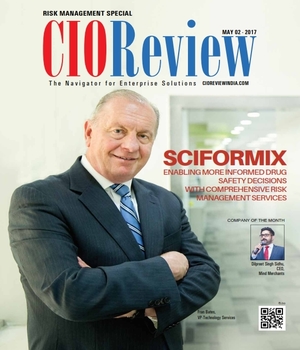
The CIO's Imperatives in IT - Enabled Productivity
Satyen Vyas, President and CEO, SUMMIT IT Solutions Pvt Ltd.
 We live in an age where change executed by regulatory or market forces is speedy, radical and comprehensive. Businesses today encounter near-constant upheaval, which they can withstand and even benefit from when supported by a rejuvenated IT organization. In fact, in today's change-driven environment, it has become imperative for IT to transform from its traditional function as a technology provider and become an adaptive, responsive and nimble organization.
We live in an age where change executed by regulatory or market forces is speedy, radical and comprehensive. Businesses today encounter near-constant upheaval, which they can withstand and even benefit from when supported by a rejuvenated IT organization. In fact, in today's change-driven environment, it has become imperative for IT to transform from its traditional function as a technology provider and become an adaptive, responsive and nimble organization.
This transformation cannot occur without the CIO leading the renewal. CIOs must shift from reactively supporting business needs, to spearheading the structural and cultural change needed within the IT organization in order to drive business process innovations that support the entire corporate agenda.
Propelled by big data and analytics as ‘must-have’ capabilities, the pace of technology change and innovation has assumed stunning proportions. There is also a powerful need for social technologies to integrate employees, customers and suppliers.
With such powerful forces of technology in motion, the question arises – what are the key imperatives for IT-enabled productivity?
Smart Service Management
CIOs need intelligent solutions that leverage the latest technological advancements - mobility, analytics and automation - to improve productivity of IT service operations and reduce their cost and complexities. They look for platforms that have
• A unique approach to analytics and predictive technologies
• Combine correlation of contextual data from disparate systems to provideoperational intelligence
• Enable IT analysts with enhanced situational awareness of their IT environment and recommend corrective actions for incidents and problems in real me for higher first call issue resolutions
Flexible Asset Redeployment
Lowering the cost of technology investments, increasing ROI, and bringing IT resources in line with core business objectives are business outcomes that CIOs look to achieve. They need multi-tenant solutions that optimize organizational efficiency and productivity by managing IT and non- IT assets across the entire asset lifecycle (via agent-less or agent-based discovery mechanisms) to mitigate risk, reduce cost, and improve return on investments.
Cloud delivered IT is a resilient and dependable option to consolidate assets and monetize underused assets by creating services from them. Such flexibility of asset reinvention gives rise to increased productivity and efficiencies.
Dependable Availability
Imagine a platform designed to collect and monitor the availability and performance data across the entire enterprise help an organization’s productivity. Imagine the flexibility of having such a platform on premises or on cloud, using an agent-based or agent-less technology – for both service providers and enterprise customers.
CIOs need this dependability of availability management solutions to enable their enterprises
• Monitor data center assets in quick time
• Realize the business value of their services
• Accelerate problem resolution
• Achieve self-healing and proactive issue prevention
And when social features are embedded into an organization’s digital ecosystem of products, markets, and business systems collaborative social platforms, they could turn out to be powerful catalysts for distributed information and problem solving.
Comprehensive Project Management
A unified and comprehensive platform that provides a 360-degree view of project execution and its implications of all IT projects will empower the CIO’s office to manage their organization’s projects more efficiently. They need insightful dashboards and charts to allow comparisons, provide visibility and enhance communication for faster, more intuitive and accurate decision making.
The Internet of Things (IoT) can give rise to smart networks to run many complex systems and operations. For example, utility grids may be programmed to meet spikes and troughs of power requirements; manufacturing assembly line may adjust production schedules based on demand data that flows in from various internal and external sources; programming for smart cities in terms of security, infrastructure facilities, healthcare and traffic management.
The possibilities are immense. Cloud-based and integrated IT operations management platforms can unify key applications across service management, asset management, availability management and project management. Realizing tight integration across key IT operations will dramatically reduce cost and complexity of IT operations besides multiplying efficiency, productivity, predictability and control.
Cognitive Computing for Enhanced User Experience
Multiple revolutions in technology have led to the availability of an abundance of data, which is widely emphasized as the ‘new currency’ or the ‘new natural resource’, affecting not only business but practically every aspect of technology-driven life. For enterprises, mining this wealth of data through cognitive computing techniques like Artificial Intelligence (AI) and Machine Learning (ML) is disrupting every sphere of operation, including IT Service Management, to the extent that companies have to migrate to this new reality in the IT landscape or risk falling behind the curve. Gartner, the IT analyst firm has named AI and ML as one of the top 10 strategic technology trends for 2017.
How do AI and ML reinvent the digital workplace? For starters, the element of automation in AI facilitates auto-completion of routine tasks, speeds up ticket resolution process, enables smoother execution of workflow and eliminates human error in the IT service delivery chain. It therefore comes as no surprise that Gartner predicts that by 2019, those IT service desks utilizing machine-learning-enhanced technologies and AI will free up to 30 percent of support capacity.
Conclusion
As innovation in technology grows bolder and grander in scale, the processing capacities of devices, machines and IT systems are designed to rationalize and predict events like humans, minus the propensity for bias and error. This anthromorphizing of technology has created a platform for enterprises to intensely compete with each other to deliver seamless customer satisfaction. Even employees are increasingly viewed as consumers of IT services within an enterprise and the fulfillment of their expectations in the digital workplace has a direct impact on their productivity. In such complex times, the CIOs should pay close heed to emerging technologies and devise means to adapt to those changes, even if it means realigning company goals and functions.
CIO Viewpoint
Upcoming Technological Advancements in Payments...
By Pinak Chakraborty, CIO of Airtel Payments Bank
Shaping the Future of AI: Talent, Innovation,...
By Yann LeCun, Chief AI Scientist at Meta
Future of Smart Manufacturing: Integrating Tech...
By Mohammed Kaishulla, Chief information officer, EPACK Durable
CXO Insights
Building Resilience through Robust Operational...
By Shankar Bhaskaran, Managing Director – India, MetricStream
Project Management and Risk Planning
By Suresh .V. Menon; IASSC Certified Six Sigma Black Belt & Member RSISInternational.org
The CIO's Imperatives in IT - Enabled Productivity







